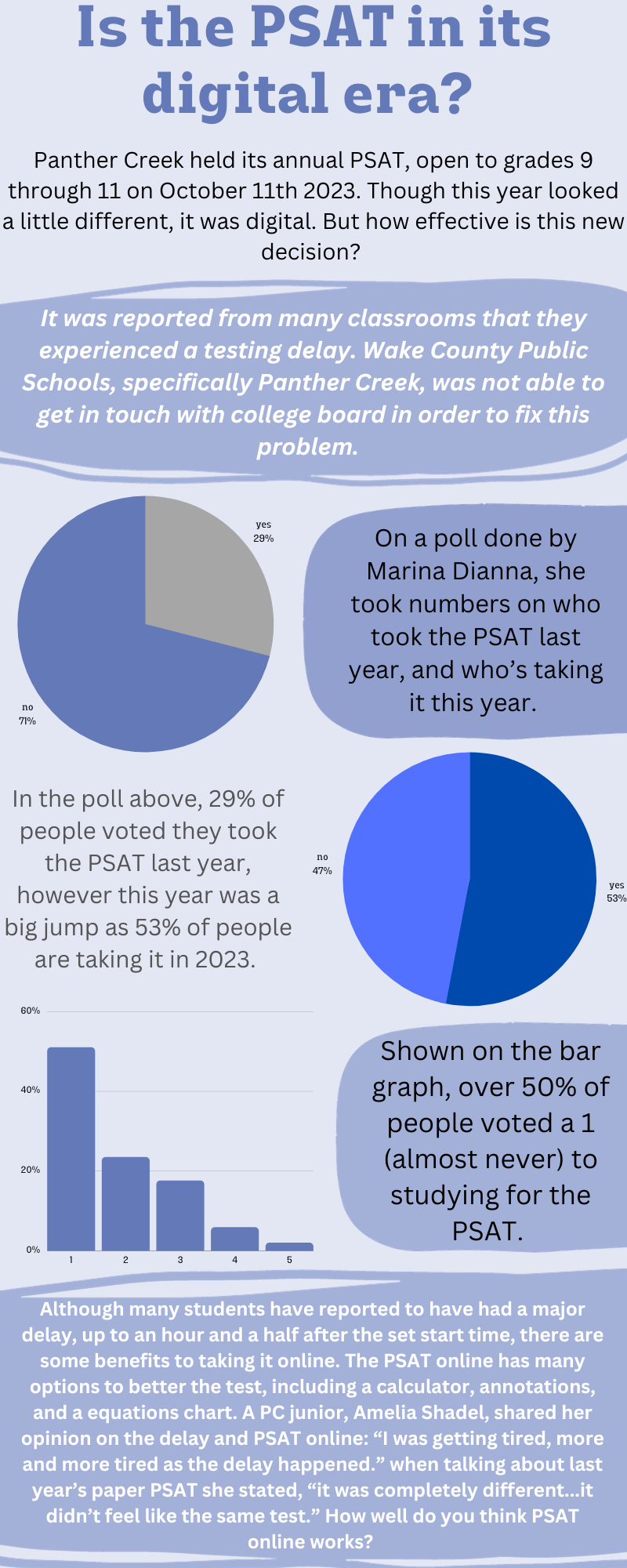 On October 11, students grades nine through eleven had the opportunity to take the first ever digital PSAT in Panther Creek history. The test is widely viewed as a way to prepare for the SAT later in the year and to possibly qualify for a national merit scholarship. Several classrooms experienced serious delays and were not able to start the test until Wake County and College Board solved the connection issues. This took up to two hours in some classes. This problem, combined with new formatting of the test, leads the school to consider if keeping the digital version of the PSAT is worth it in the coming years.
On October 11, students grades nine through eleven had the opportunity to take the first ever digital PSAT in Panther Creek history. The test is widely viewed as a way to prepare for the SAT later in the year and to possibly qualify for a national merit scholarship. Several classrooms experienced serious delays and were not able to start the test until Wake County and College Board solved the connection issues. This took up to two hours in some classes. This problem, combined with new formatting of the test, leads the school to consider if keeping the digital version of the PSAT is worth it in the coming years.
PCHS interviewed several students who took the PSAT this year. Most reported the test having built-in annotation tools and the ability to mark a question for review as an advantage of this version that was not available in the paper test. However, of those interviewed, three fifths reported a significant delay in the start of testing. Amelia Shadel, a junior at PC, wasn’t able to begin her test until 9am, almost an hour and a half after students were required to report to their testing rooms.
Another junior, Anna Higley, had a similar problem. She said the delay made her “really bored. I was getting tired, more and more tired as the delay happened. That was not helpful [for testing].” She also explained that she had taken the paper version of the PSAT before and that “it was completely different… it didn’t feel like the same test.” There is, however, a reason for that.
Even without the connection issues, the PSAT this year was still different from the paper versions of previous years for one main reason: the adaptive aspect. The test this year was programmed to place test takers in different levels based on how they performed in the first section of questions. For example, a student that performs well in the first section is automatically placed in a level with more difficult questions in the next sections. This change was made as a method to more easily reach a student’s final score, but it may not be worth it with the difference in the process.
The program gives no indication of which level the student is placed in, but the placement does affect overall test scores. If a student in the lower section and a student in the higher section both answered all questions correctly, the student in the higher section would still receive a higher score for their test. The paper version used in past years did not have this feature; all students had the same test with the same questions.
While it is worth noting that PCHS administration hosted widespread instructional meetings detailing this change, not all students were aware of the implications of the testing levels, and many did not think it was a fair process. Shadel thought that “It should be based off of how well you do and how many questions you get correct; not based off of how hard your questions were.”
Another student who took the test was not aware of this process at all. When it was explained to her, Abby Annadurai said “That doesn’t seem fair at all… It should be equal for everyone… everyone’s different and it makes sense to test them on something that is the same as everyone else.” Others agreed with her sentiment, saying “I think they should be the same for everybody.”
Austin Soward’s opinion sees the issue as “a gray area”. The student said, “On one hand, providing the same test for every student isn’t going to cover everybody but at the same time you still have the people… that haven’t taken all the… classes.”
This leaves the question: should PCHS stick with the digital version for next year?
Students had the answer: With a few adjustments, yes.
The students interviewed agreed that the digitized version of the PSAT saves paper, has an automatic timer for students to pace themselves, and is more efficient by using the BlueBook app. However, most think the grading process should be modified in order to equitably represent students. We will see what the next years bring for PCHS and standardized testing, but for now, test takers will have to wait for their scores to be released from College Board in the next few weeks.





